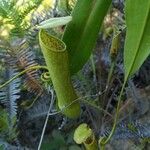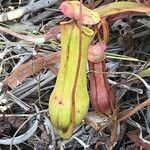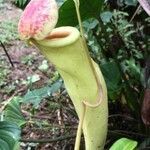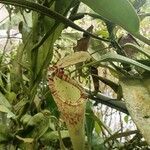Compact subshrub to straggling vine, generally 0.4–4 m high; stems terete, flexuous, generally less than 8 mm diam. Leaves chartaceous, petiolate, 10–35 cm long, 2–7 cm wide, oblong to lanceolate, basally attenuate into narrowly winged petiole generally 5–10 (–20) cm long, acute to obtuse at the apex, margin entire to minutely fimbriate-denticulate, longitudinal veins 5–7 on each side of the midrib, tendril usually shorter in length than lamina. Lower pitchers ovoid in the basal third, narrowing slightly to form a hip and cylindric above, generally up to 18 cm long and 5 cm wide, subglabrous to slightly pubescent with simple and stellate hairs, a pair of ventral wings usually present, running from below the mouth to the tendril, usually with multi-cellular fringe elements to 7 mm long, mouth generally slightly oblique, without a column, peristome subcylindric to slightly flattened, usually 2–4 mm in width throughout, teeth of interior margin minute. Lid orbicular to ovate, apex rounded to slightly retuse, base subcordate, 3–6 cm long, abaxial surface densely glandular, spur simple or with few branches, 3–6 mm long. Upper pitchers similar in overall shape, but up to 25 cm long, the wings reduced to narrow, afimbriate ridges and the ventral surface slightly flattened. Inflorescence a racemose panicle, subpubescent throughout, peduncle 0–20 cm long, rachis 20–30 cm long, usually abracteate; pedicels 5–15 mm long, lacking bracteoles, tepals 5–8 mm long, ovate to oblong, adaxial surface bearing large, elliptical glands, abaxial surface pubescent; female inflorescences generally shorter than males; tepals 4–5 mm long, fruits to 30 mm long, densely pubescent, seeds filiform, usually c. 12 mm long. Pitchers generally deep red throughout, but sometimes green, particularly in the uppers.
Herbs erect or climbing, 0.5-2 m tall. Basal leaves densely rosulate, subsessile, base amplexicaul; leaf blade lanceolate, ca. 10 cm, margin usually denticulate; tendril shorter than blade; pitcher narrowly ovoid to subcylindric, variable in size, 2-7 cm, pubescent with simple and stellate hairs, 2-winged, 2-8-spurred between lid and mouth, lid ovate or rounded, glandular inside. Cauline leaves petiolate; leaf blade dotted purple-red on both surfaces, oblong to lanceolate, 10-25 cm, with 5-7 pairs of longitudinal veins, base prolonged, margin entire or denticulate; tendril nearly as long as blade; pitcher cylindric, slightly dilated basally, 6-21 cm, subglabrous to pubescent with simple, furcate, and stellate hairs, wings 2, fringed, proximal part of inside wall of pitcher glandular, distal part smooth, mouth 1.5-5 cm wide, lid ovate to oblong, ca. 4.5 cm, densely glandular with all glands orbicular, spur 1-3-branched, dorsiventrally compressed. Raceme 20-50 cm, weakly pubescent; pedicels 0.5-1.5 cm. Tepals 4, red to purplish red, elliptic or oblong, densely glandular adaxially with elliptic glands, villous abaxially. Male flowers: perianth 0.5-0.8 cm; stamens in 1 whorl, slightly contorted. Female flowers: perianth ca. 0.5 cm; ovary elliptic, shortly stipitate or subsessile, densely pubescent with light yellow villi or stellate hairs. Capsule brown, 1.5-3 cm; valves 4, lanceolate. Seeds filiform, ca. 1.2 cm. Fl. Mar-Dec, fr. Aug-Dec(-Mar).





